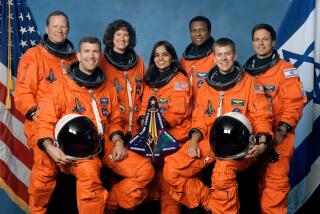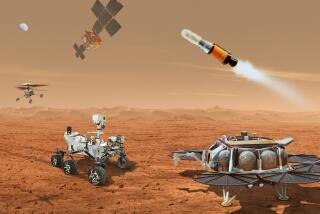Ground control to NASA TV: liven up
If they can put a man on the moon, why can’t they create interesting television?
Though the question could be aimed at any number of networks, it is perhaps most aptly directed at the people who really did put a man on the moon -- the clever workers at NASA, who are appearing in more living rooms than ever thanks to the expanding lineups of satellite and cable networks. Viewers who tune in to NASA Television for the first time might rightly expect to be starry-eyed with wonder at the incomprehensible mystery and vastness of space.
This is, after all, an era of profound discovery, when space telescopes beam back images of galaxies and nebulae in the remote reaches of the heavens, when crews come and go from the International Space Station, when probes hurtle toward Jupiter and beyond.
But clearly, a universe of possibilities does not assure an abundance of riveting programs. Witness one recent segment about the recovery of a Soyuz capsule upon its return to Earth. The dark, bullet-like object landed in the featureless steppes of Kazakhstan, about 50 miles outside the unheard-of town of Arkalyk. Coverage consisted of video shot from an all-terrain vehicle approaching it -- mostly soundless footage of tall grass going by -- with an occasional word by an unnamed commentator.
“You can see the antenna that deployed shortly after landing,” the commentator said in that deadpan tone shared by scientists and golf announcers. The camera chronicled the tedious extraction of three crew members weakened by spending six months in orbit; they were loaded one by one onto stretchers.
“Again, a rather methodical process,” the commentator noted, as if grasping for something -- anything -- to say. Later: “The official landing time has been revised to 1:15 and 34 seconds a.m., Central Time. The official time was recorded at the Russian Mission Control Center . . . by the Russian flight-control team.”
Technical detail and dead air are distinctive staples of NASA TV programming. Typical shows feature live coverage of space-station activity, space shuttle launches, news conferences, wrap-ups of space-related news, and educational programs about such topics as asteroids and climate change on Earth. One frequent camera angle shows engineers sitting like automatons at consoles in the Mission Control room of the Johnson Space Center in Houston. During a recent telecast, the only action occurred when a man stood up and walked down an aisle, presumably hunting for a restroom.
Utter silence dragged on for 35 seconds, followed a moment later by 11 more seconds of nothingness.
Where is Carl Sagan when you need him?
“There are times . . . when I think to myself, ‘Wow, in five minutes I’ve listened to something I was really interested in and I’ve managed to become really bored,’” said Robert Thompson, a professor of television and popular culture at Syracuse University. “Science, and especially science having to do with the exploration of space, has the potential to be exciting. But they’ve struggled. There’s been a strange disconnect.”
Like all too many viewers, Thompson wonders how it can be. He yearns for a broader mix of programming and for hosts who can translate mathematics and scientific jargon into concepts that laymen can understand -- and with sufficient panache, he said, to “avoid putting people to sleep.”
“Let’s face it, to program television takes special, sophisticated skills,” Thompson said. Just as the average television director can’t calculate the orbital trajectory of a comet, “you can’t expect a highly placed space scientist to sit in a chair, strap on a mike, and talk compellingly to a TV audience for an hour. People who have been trained in the skills that make you a great scientist don’t necessarily have the kind of skills that work in show business.”
Humble beginnings
The man in charge of Washington, D.C.-based NASA Television, executive producer Fred Brown, acknowledges that the network is light-years from where it could be if it had the money and a mandate to properly entertain the masses. But that was never the point, he said. The network was launched in the early 1970s strictly to provide “real-time mission coverage” for NASA’s own personnel, Brown said.
“It wasn’t designed as a television channel as most people would think of a television channel,” he added.
Over the years, its role has grown; it now offers educational programs and serves a public-relations function by keeping the media informed about space-related news.
It has also become far more widely available lately -- by satellite on DirecTV and the Dish Network, by cable on Comcast, Time Warner, Cox and other systems, and on the Internet at www.nasa.gov, Brown said. The service is provided free to the channels.
No one at NASA even knows how many viewers see the programming, since the federal agency does not bother to pay for Nielsen data, Brown said.
However, NASA officials see spikes in Web hits during shuttle launches and spacewalks and are well aware of the “shadow audience” of perhaps millions of nonscientists -- and, in a perfect world, would offer more fare tailored to them.
“But it’s not a perfect world,” Brown said.
The network’s budget -- $1.5 million a year -- is a pittance even compared with certain programs on National Public Radio, he said, and NASA TV’s full-time staff of 18 people, based in Washington, D.C., cannot hope to create the sort of polished productions that grace “Nova” and the Discovery Channel.
Some media scholars, like Fordham University’s Paul Levinson, believe NASA TV could greatly benefit the space agency -- and thrill the public as well -- if it could broaden its lineup to address the politics of space exploration, report the goings-on in other countries, show archival network coverage of early missions, and perhaps even ponder the philosophical and spiritual implications of the boundless cosmos.
But in the meantime, the network’s greatest strength is beaming home the occasional stunning bit of footage that can’t be seen anywhere else in the solar system -- as it did in June during a spacewalk to repair the Hubble Space Telescope.
“It’s true, you can’t sit there and watch it for hours -- you can’t,” said Rob Frankel, a Los Angeles resident and brand strategist who nonetheless considers himself a huge fan of the channel. The draw, he said, is that it’s real.
“There are guys out there risking their lives in a tin can. It’s spellbinding. They’re talking about the most mundane things or abstractions . . . checking gas pressure gauges or the viability of a gasket or something, and you’re hearing this team of people down on Earth, and you realize they’re taking care of each other. . . . The next thing you know, 45 minutes has gone by.”
Martin Kaplan, a professor of entertainment, media and society at USC, rarely bothers to watch, except when he was writing the script for the television movie “Max Q: Emergency Landing,” about a fictional, trouble-marred space shuttle mission.
“I wanted maximum geekiness,” he said. “For my purposes, it was perfect.”
A smashing discovery
The discovery this fall of water on the moon -- one of the most significant moments in the history of science -- offered an especially revealing glimpse of NASA Television on the job. The achievement involved smashing a 5,000-pound probe into the moon at 5,600 mph and analyzing readings from the resulting plume of dust and vapor.
Befitting its growing awareness of the world looking on, NASA TV later put its coverage on YouTube. However, the soundtrack is filled with technical gibberish as scientists ready their instruments, and the impact itself is virtually invisible.
Web posts were merciless: “NASA needs to pay me 8 minutes and 12 seconds’ worth of labor [for] watching this video,” one said.
Another lamented, “This may be the greatest discovery in human history, and they do it with the [crappiest] camera possible. . . . Come on, NASA!”
A separate video, filmed later, shows the space agency’s Anthony Colaprete answering questions about one of the triumphs of the ages.
Scientists “kept coming back to a dip on the spectrometer,” he said with all the joy of a man reporting that his transmission had gone out. The reading could only be accounted for, he said, when two team members independently concluded that it must be water.
“That was the eureka moment,” Colaprete said.
Champagne? Joyous celebrating?
What came next?
Colaprete stared straight into the camera. “And then we vetted it and we vetted it and we vetted it and vetted it some more.”
More to Read
The complete guide to home viewing
Get Screen Gab for everything about the TV shows and streaming movies everyone’s talking about.
You may occasionally receive promotional content from the Los Angeles Times.






